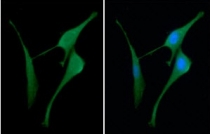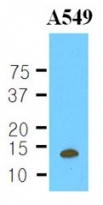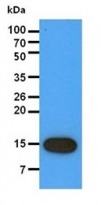ARG56951
anti-Cystatin B / Stefin B antibody [2F1]
anti-Cystatin B / Stefin B antibody [2F1] for ICC/IF,Western blot and Human
Overview
| Product Description | Mouse Monoclonal antibody [2F1] recognizes Cystatin B / Stefin B |
|---|---|
| Tested Reactivity | Hu |
| Tested Application | ICC/IF, WB |
| Host | Mouse |
| Clonality | Monoclonal |
| Clone | 2F1 |
| Isotype | IgG2b, kappa |
| Target Name | Cystatin B / Stefin B |
| Antigen Species | Human |
| Immunogen | Recombinant fragment around aa. 1-98 of Human Cystatin B / Stefin B. |
| Conjugation | Un-conjugated |
| Alternate Names | Liver thiol proteinase inhibitor; EPM1; CPI-B; EPM1A; Cystatin-B; Stefin-B; PME; CST6; ULD; STFB |
Application Instructions
| Application Suggestion |
|
||||||
|---|---|---|---|---|---|---|---|
| Application Note | * The dilutions indicate recommended starting dilutions and the optimal dilutions or concentrations should be determined by the scientist. |
Properties
| Form | Liquid |
|---|---|
| Purification | Purification with Protein G. |
| Buffer | PBS (pH 7.4), 0.02% Sodium azide and 10% Glycerol. |
| Preservative | 0.02% Sodium azide |
| Stabilizer | 10% Glycerol |
| Concentration | 1 mg/ml |
| Storage Instruction | For continuous use, store undiluted antibody at 2-8°C for up to a week. For long-term storage, aliquot and store at -20°C. Storage in frost free freezers is not recommended. Avoid repeated freeze/thaw cycles. Suggest spin the vial prior to opening. The antibody solution should be gently mixed before use. |
| Note | For laboratory research only, not for drug, diagnostic or other use. |
Bioinformation
| Database Links | |
|---|---|
| Gene Symbol | CSTB |
| Gene Full Name | cystatin B (stefin B) |
| Background | The cystatin superfamily encompasses proteins that contain multiple cystatin-like sequences. Some of the members are active cysteine protease inhibitors, while others have lost or perhaps never acquired this inhibitory activity. There are three inhibitory families in the superfamily, including the type 1 cystatins (stefins), type 2 cystatins and kininogens. This gene encodes a stefin that functions as an intracellular thiol protease inhibitor. The protein is able to form a dimer stabilized by noncovalent forces, inhibiting papain and cathepsins l, h and b. The protein is thought to play a role in protecting against the proteases leaking from lysosomes. Evidence indicates that mutations in this gene are responsible for the primary defects in patients with progressive myoclonic epilepsy (EPM1). [provided by RefSeq, Jul 2008] |
| Function | This is an intracellular thiol proteinase inhibitor. Tightly binding reversible inhibitor of cathepsins L, H and B. [UniProt] |
| Calculated MW | 11 kDa |
Images (4) Click the Picture to Zoom In
-
ARG56951 anti-Cystatin B / Stefin B antibody [2F1] ICC/IF image
Immunoflorescense: U87MG cell line stained with ARG56951 anti-Cystatin B / Stefin B antibody [2F1] at 1:100 (Green).
DAPI (Blue) for nucleus staining.
-
ARG56951 anti-Cystatin B / Stefin B antibody [2F1] WB image
Western blot: 35 µg of A549 stained with ARG56951 anti-Cystatin B / Stefin B antibody [2F1] at 1:1000.
-
ARG56951 anti-Cystatin B / Stefin B antibody [2F1] ICC/IF image
Immunoflorescense: A549 cell line stained with ARG56951 anti-Cystatin B / Stefin B antibody [2F1] at 1:100 (Green).
DAPI (Blue) for nucleus staining.
-
ARG56951 anti-Cystatin B / Stefin B antibody [2F1] WB image
Western blot: 40 µg of U-87MG cell lysate stained with ARG56951 anti-Cystatin B / Stefin B antibody [2F1] at 1:1000.









